Format
Web3 wallets can take different forms, and it was important to consider how such forms would impact the goals of Scale as an aspirational example of what web3 interaction, and custody could be.
The decision to develop a mobile app therefore, may seem obvious, but came only after using the Redbelly product principles to objectively and pragmaticly consider how different formats would impact user adoption, perception and experience across required processes.
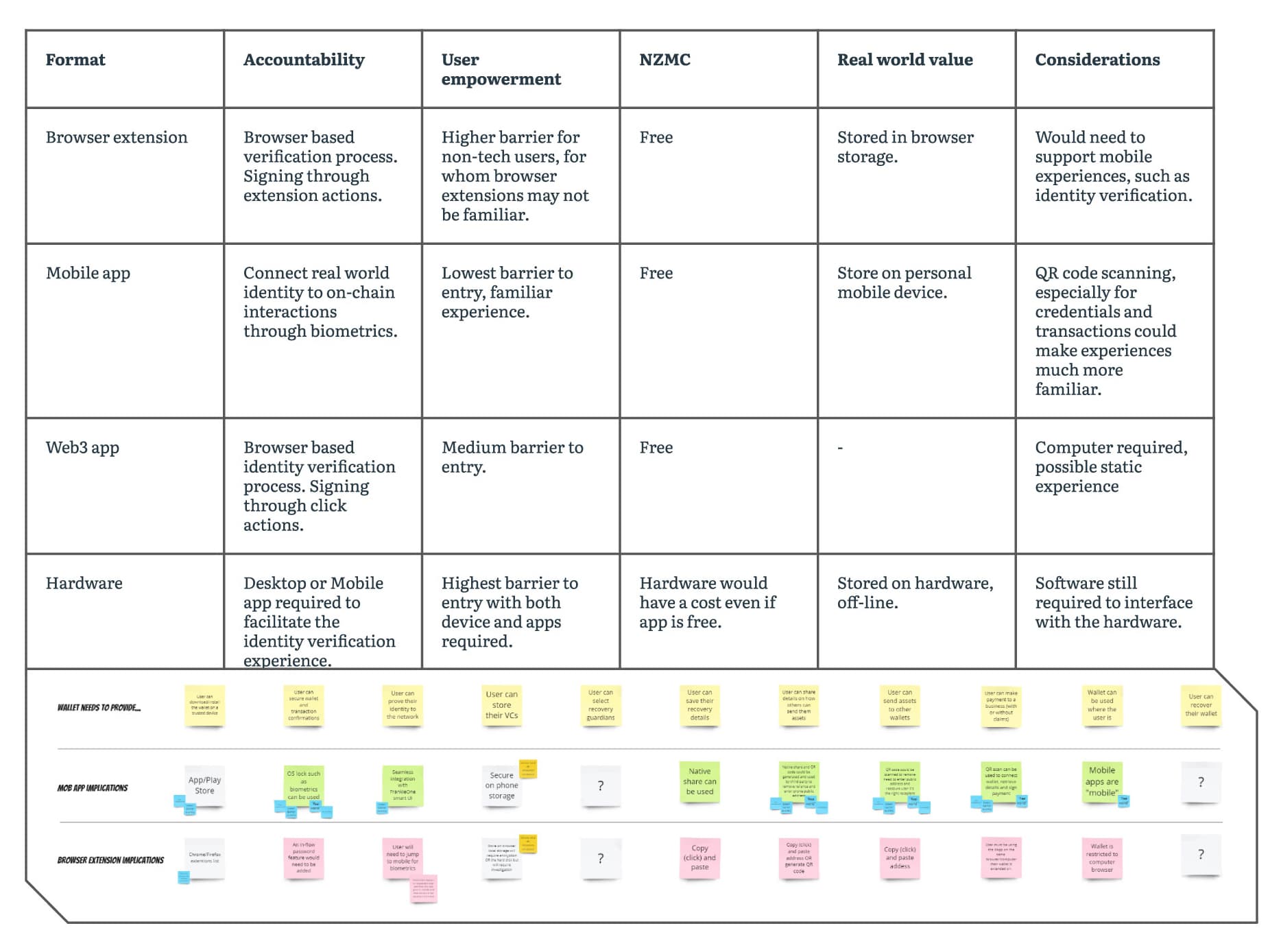 Tables from exercises which helped select the appropriate format for the Scale wallet.
Tables from exercises which helped select the appropriate format for the Scale wallet.
Scenario-based wireframing
A storyboard mapping exercise allowed interrogation of key scenarios by asking, “then what?” and “what if?” as I designed key parts of the flows. The assets below help align stakeholders, and enable engineers to architect the solution. They intentionally DON’T focus on asthetic and usually display content in a conversational style between the user and the interface to empathise and fill gaps.
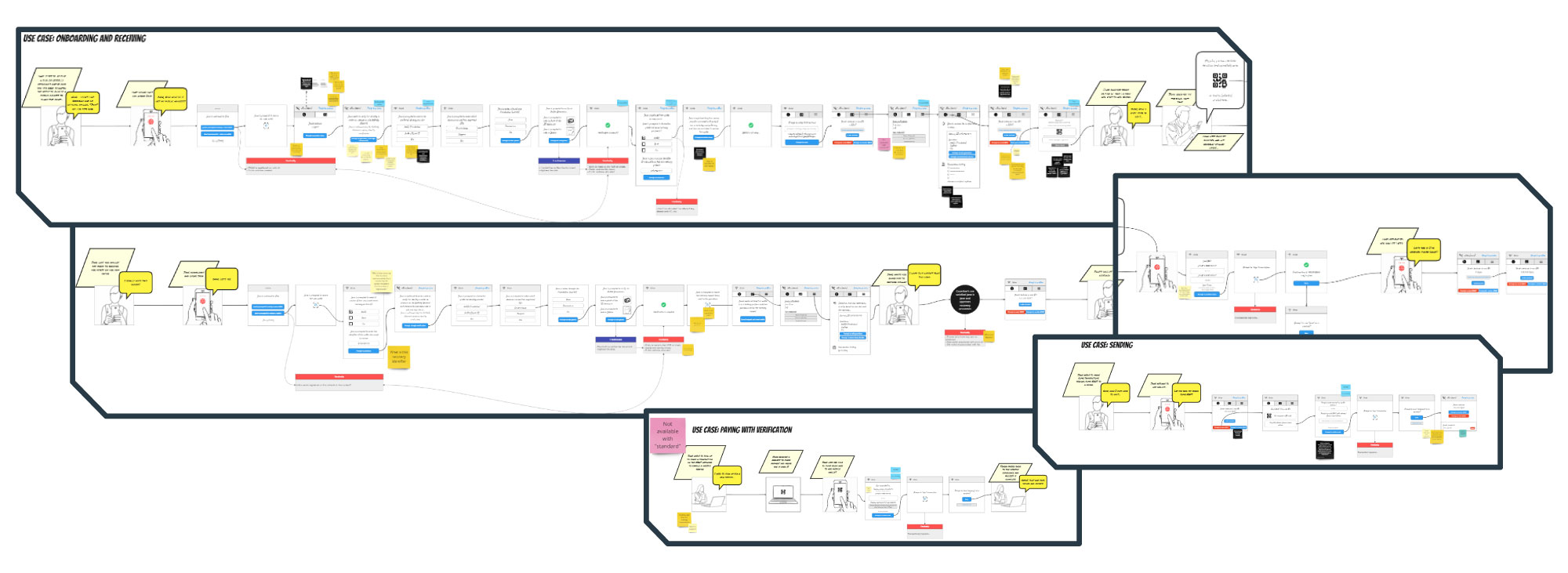 Early wireframe/storyboard hybrid for the Scale design.
Early wireframe/storyboard hybrid for the Scale design.
UI Design
Once clarity and alignment of the flow was , leveraging the Redbelly Design System to design and build a prototype. The prototype offered further clarity to engineers and allowed for realistic user testing to be undertaken to validate assumptions.
Onboarding and identity verification
Security and identity are intrinsically linked so it was important for users to understand that a personal device secured with strong operating system (OS) security would be required. Leveraging the OS security ensured no third-party was involved between the local device and the network. Identity verification was handled by an independent party, Averer, with plans to grow the pool of idenity providers to offer decentralised choice to users.
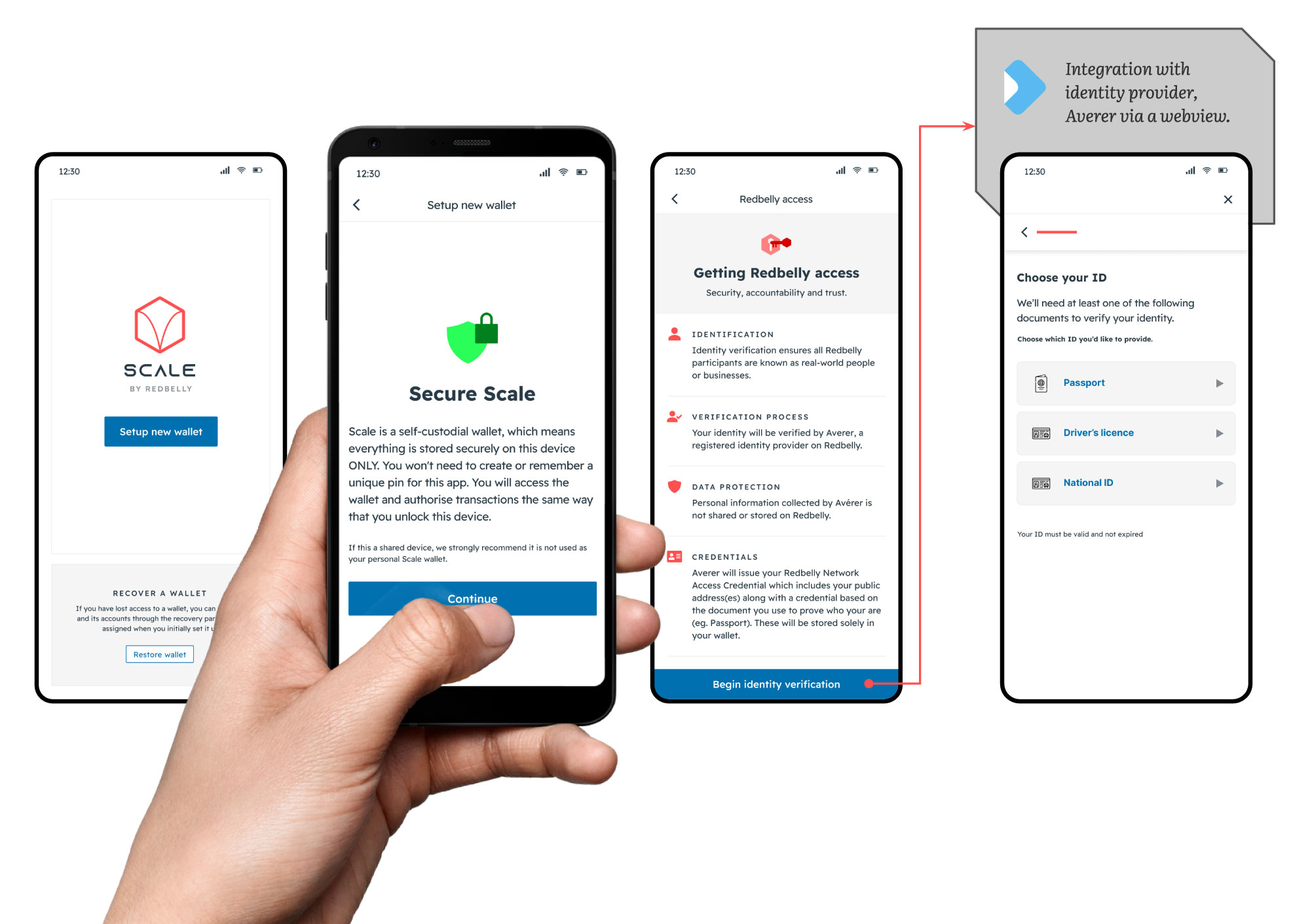 Scale on-boarding screens.
Scale on-boarding screens.
Identity and verifiable credentials
The Scale wallets supports the issuance, holding and presentation of Verifiable Credentials (VCs) to those who need to validate a customers eligibility for their product or service.
With Scale, once a user's identity is verified, they receive VCs which allow them to interact with other entities on Redbelly Network.
VCs leverage a "triangle of trust" governance framework between the credential holder (the user), the issuer (who verified their identity and documents), and any party who requires eligibility criteria be met. VCs put custody and control in user hands, giving them the authority to share only what is necessary to prove their eligibility for products of services.
Via Zero-Knowlegde Proofs, revealing information at all is often bypassed altogether, because verifiers can query data against conditions, for example, “was born before 1 Jan, 1980” to determine a users age is high enough for their service.
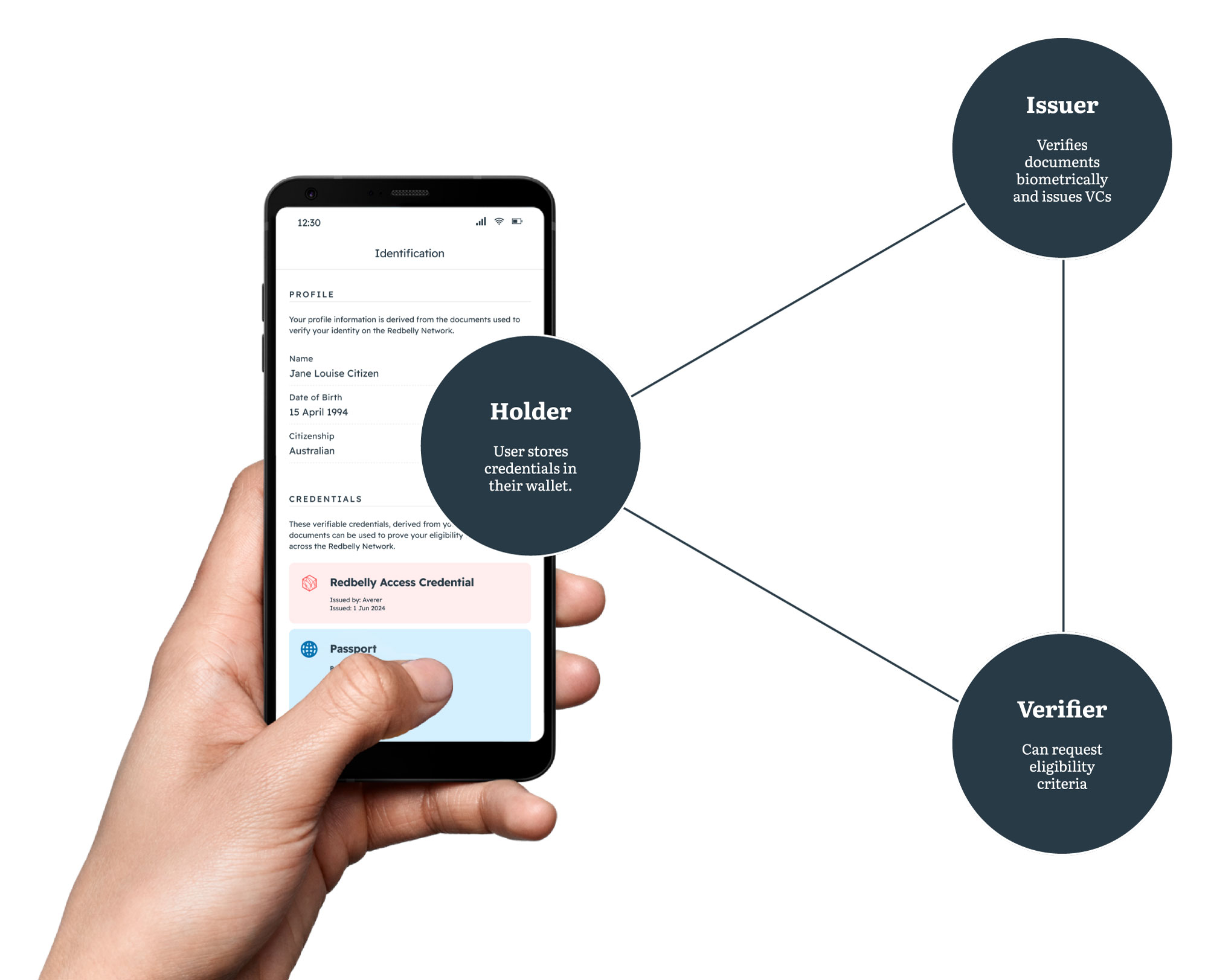 The Scale identification tab provides users visibility of their Redbelly profile and Verifiable Credentials.
The Scale identification tab provides users visibility of their Redbelly profile and Verifiable Credentials.
Recovery setup
Recovery mechanisms are critical in self-custodial servicers. In the event a user loses access to their wallet, Verifiable Credentials also play a role. Scale's recovery setup handles this by focusing on the individual actually being who they say they are, rather than just remembering a passphrase. By sharing VCs with trusted partners during wallet on-boarding, those partners can vouch for them and their identity when they need to recover or unlock the assets they own on the network.
Given Redbelly’s focus on storing Real-World Assets, real-world counterpart verification is vital to user experience.
In this flow, the user selects from a list of institutions they want to trust with their recovery, and in the time of need, at least two independent recovery partners are required to vouch for the identity associated with the recovery record before the wallet can be restored.
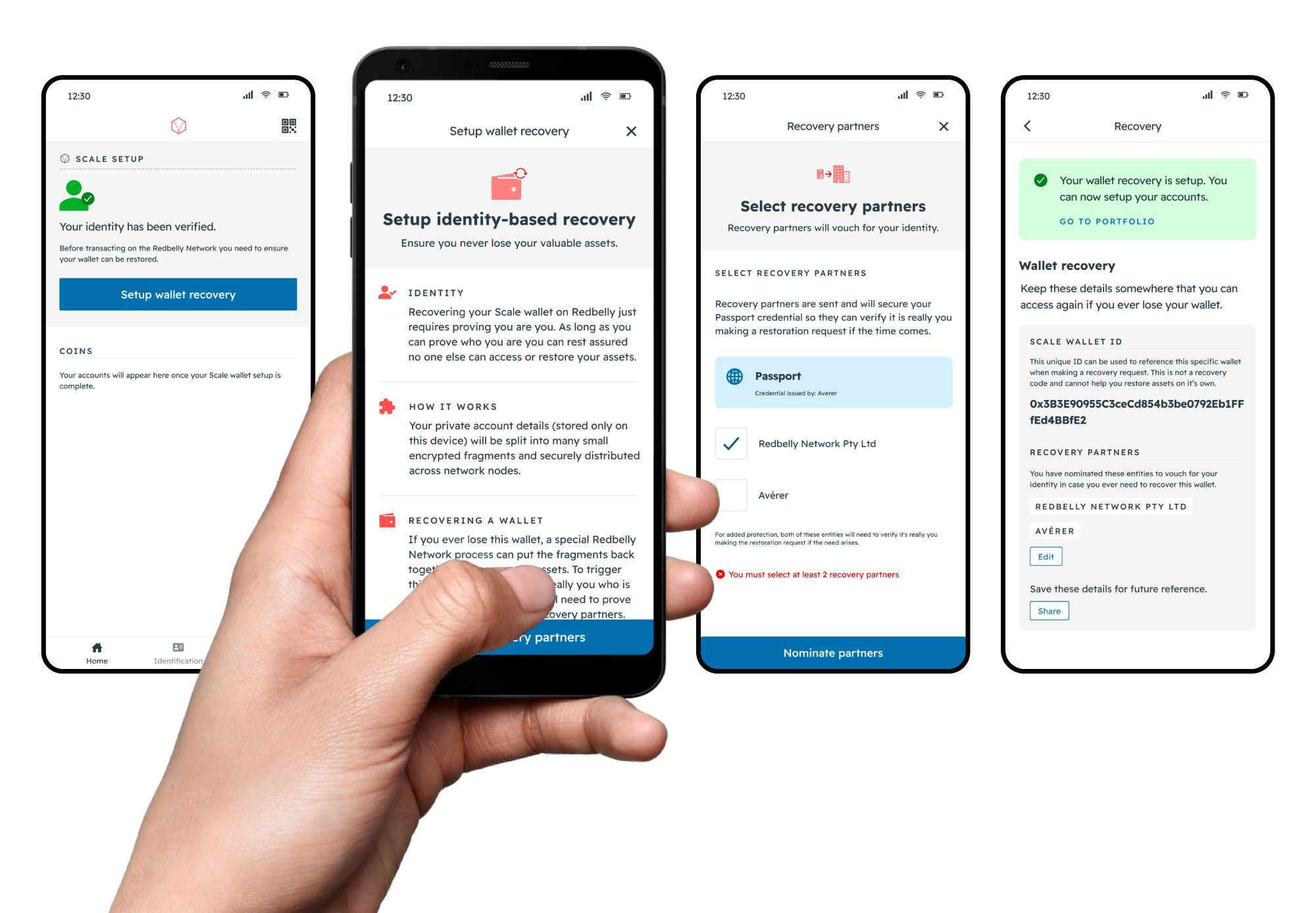 Scale recovery setup flow.
Scale recovery setup flow.
Account management
Users are allowed to create five accounts on Redbelly Network within the wallet, each tied to their identity.
This allows some flexibility for users to use different public addresses for different needs, but also limits how much the IDP pays to fund the accounts so that the user can pay the enablement fee required to sign the contract on the Redbelly Network.
Account management allows for distinct naming, and provides users with a shareable QR code to third-parties which can be used to send/receive funds.
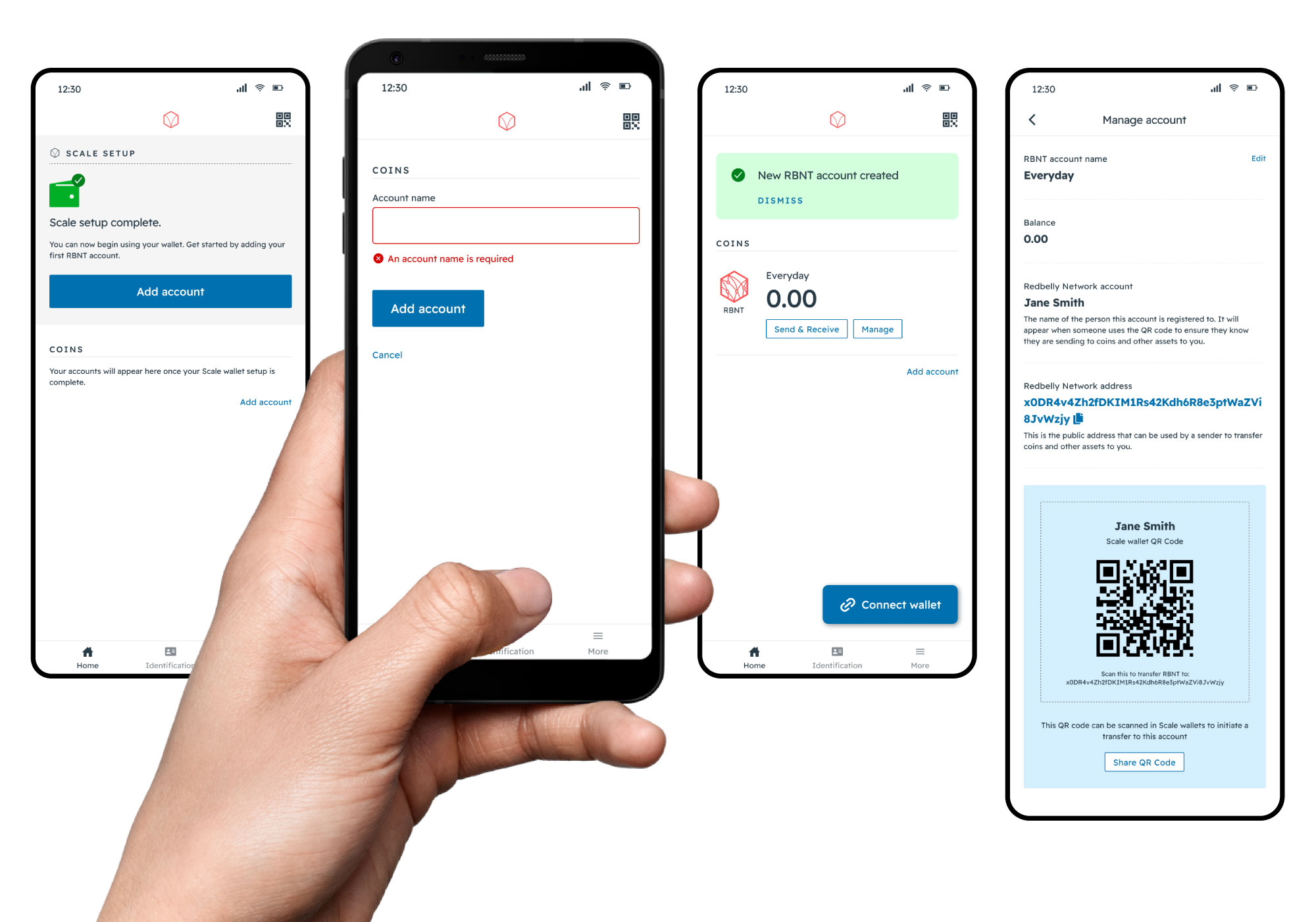 Scale account management screens.
Scale account management screens.
Transactions
Personal QR code scanning and sharing allows user to transfer funds with other network participants with increased assurance because they don't need to enter 48 character public addresses manually. The OS Biometric verification intergration is also required to confirm transactions, adding another layer of security and assurance.
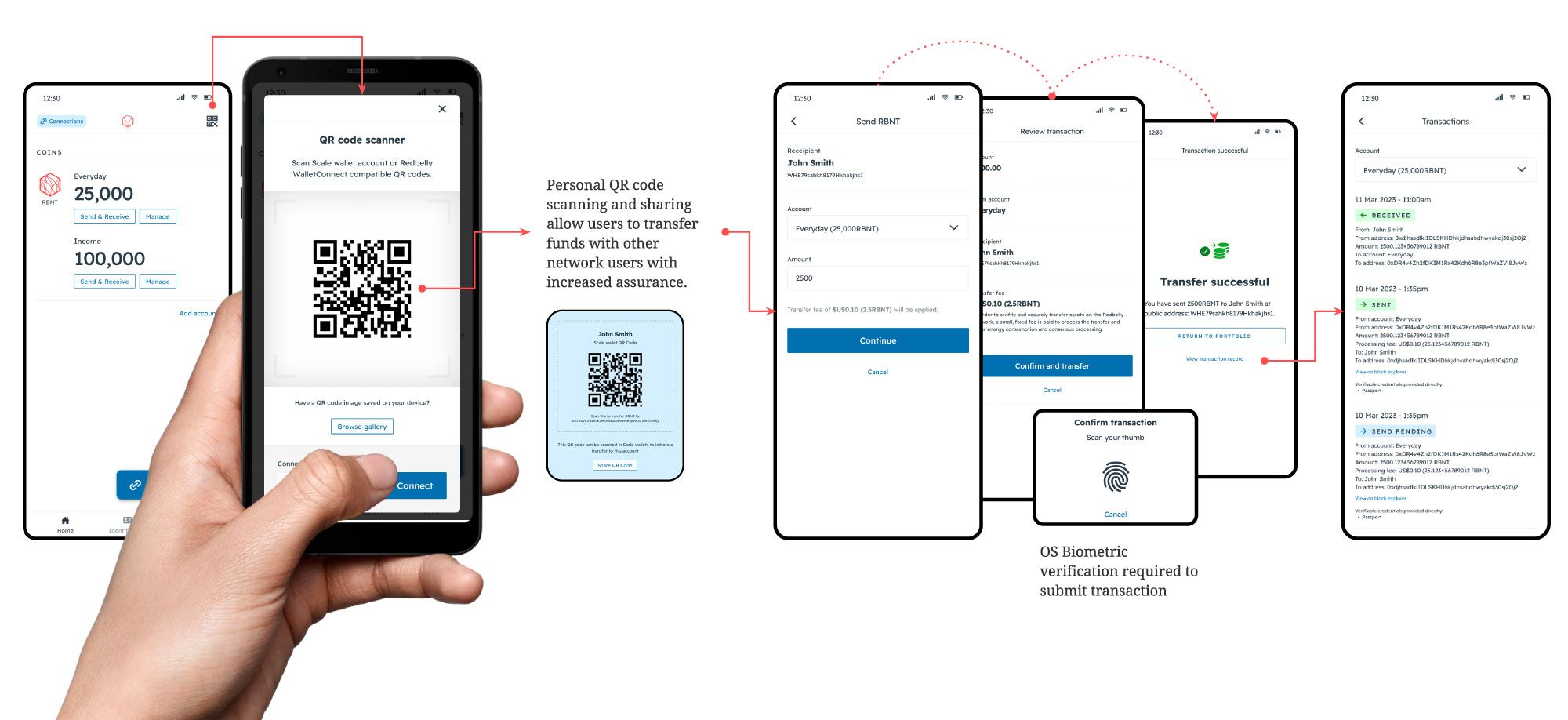 Scale transfer flows.
Scale transfer flows.
UX Testing
Once initial UI design was completed, the prototype was testing with applicable users to gain insight into:
- the wallet’s usability
- the perception of its utility
by gauging a participant’s understanding of:
- Wallet security
- Network registration
- Wallet recovery
- Accounts and transactions
Particiaption
Five participants familiar with digital finance concepts and use digital banking, payments and other wallets were selected. There was also a range of experience and knowledge regarding Decentralised Finance.
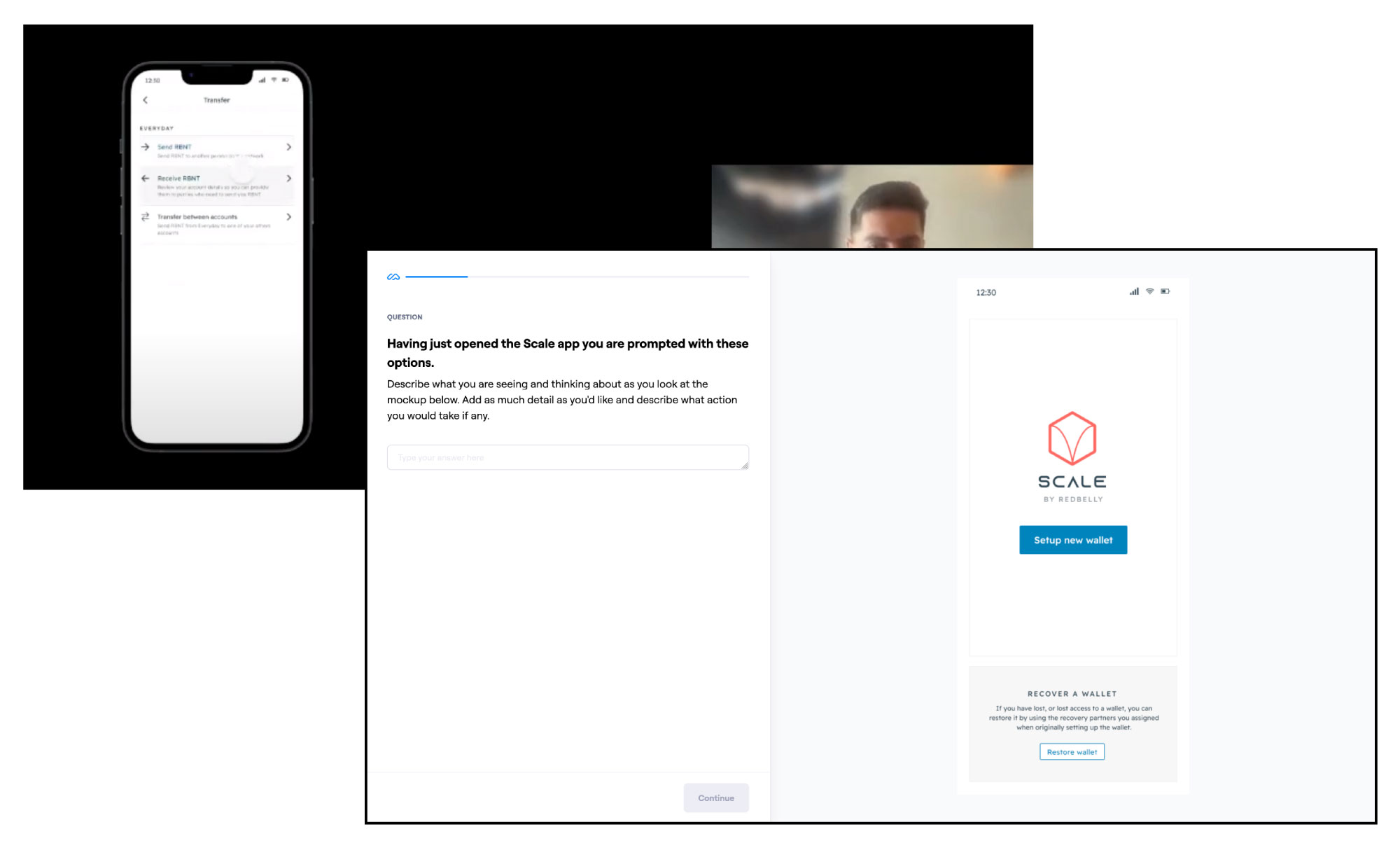 Scale participation conditions.
Scale participation conditions.
Format
- 1-on-1 interviews
- Asynchronous Q/A surveys.
Facilitation
- Thinking and actions are probed o understand why decisions are being made, or progresses is blocked.
- Special care is taken NOT to lead or instruct the participant in any way they discredits the results.
Scenario
A scenario was crafted to provide realistic conditions for why the participant would be using the wallet in the first place.
“Someone you trust (a friend or family member) has advised you that they wish to transfer a sum of RBNT to you as a means to repay a loan to you. You’ve agreed to accept the cryptocurrency as payment. Therefore, they ask you to provide your Redbelly account details so they can transfer the funds. Since you don’t have an account, they recommend using the Redbelly Official Wallet, called Scale, as a means to setup an account. You visit the App/Play Store, download, install and open the Scale app.”
Flow actions vs interpretation
To successfully complete the scenario, the participant had to:
- Secure the app with OS by allowing access to device security.
- Register on the network by going through identity verification.
- Setup their recovery by selecting recovery partners.
- Create an account by unlocking the public key.
- Find/share account details by sharing public account key.
While each partifipant was able to complete the task, we analysed their interpretation of underlying concepts throughout to ensure they were also learning about the network's distinctive features.
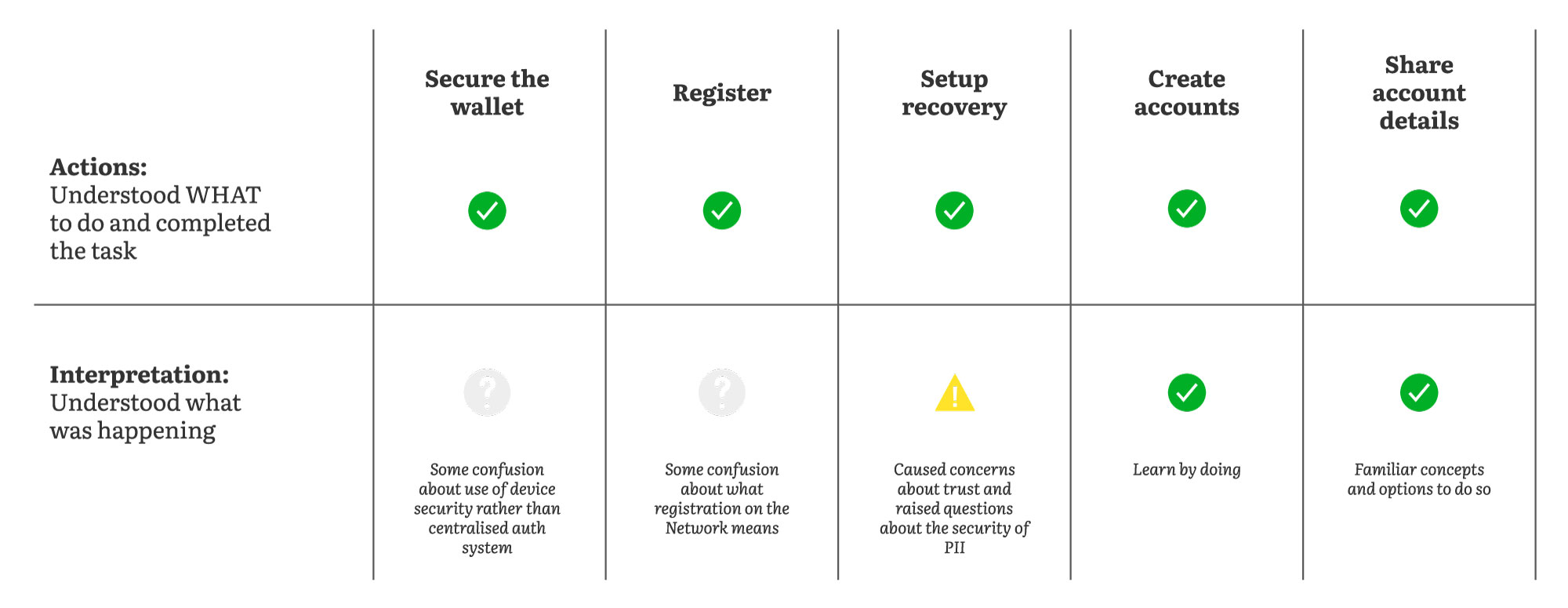 Table showing the success of each task, versus their interpretation of underlying concepts.
Table showing the success of each task, versus their interpretation of underlying concepts.
Observations
Securing new wallet
Participants skimmed and followed prompts quickly. Some confusion and/or concern about the security mechanism allowing the app to access OS authentication.
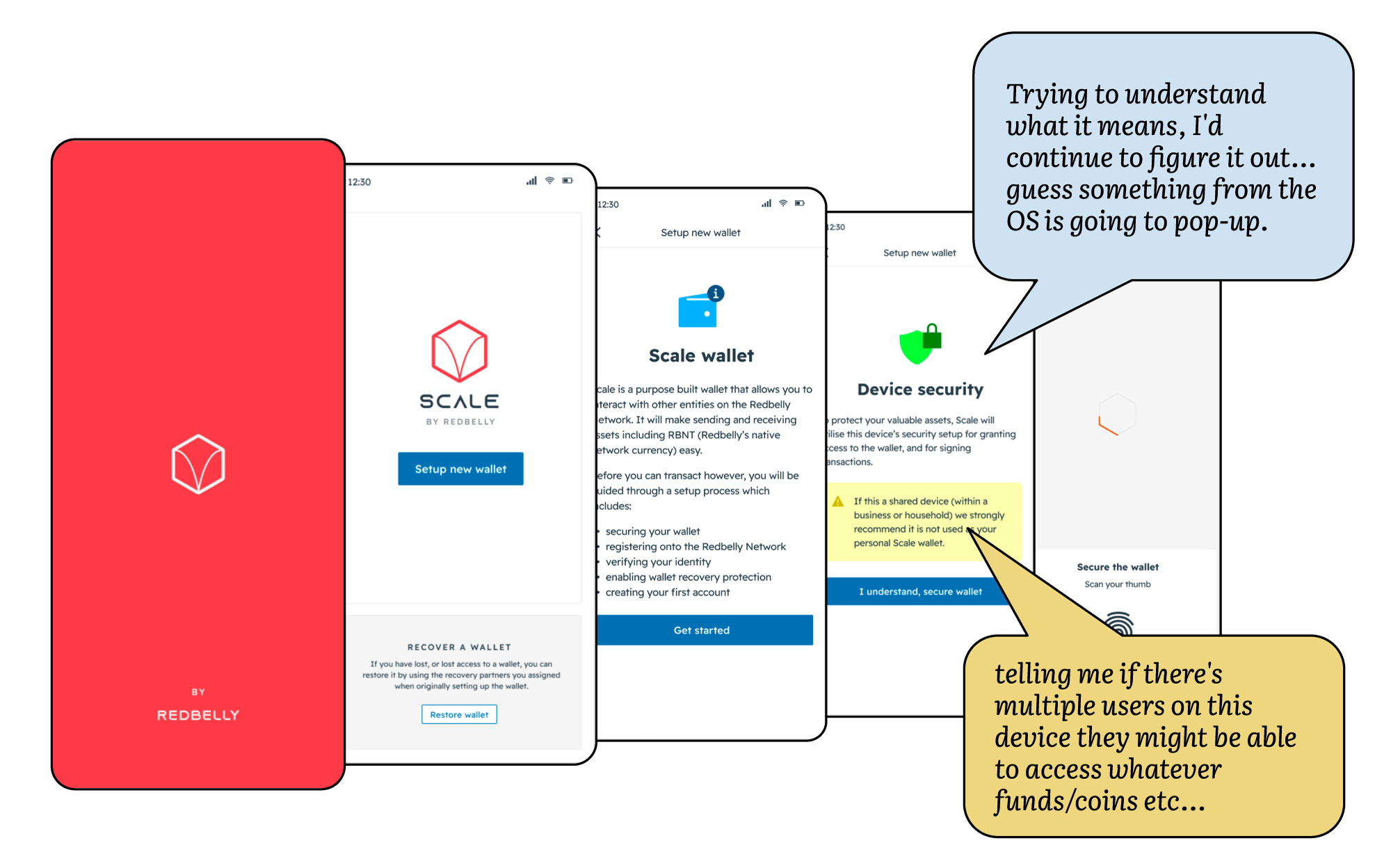 Participant feedback about the onboarding experience.
Participant feedback about the onboarding experience.
Registrations
- Participants quickly began the “register” process rather than exploring the app, even though they had noticed other tabs or features such as the QR code.
- Some assumption regarding the registration process and that Redbelly would receive PII along with identity provider.
- The verification process itself was familiar to all participants, even if they found some issues with the sequence itself.
- Users expressed the time to verify would be frustrating, especially if it took the 4 days indicated in the prototype and assumed they would just need to return to the app to check.
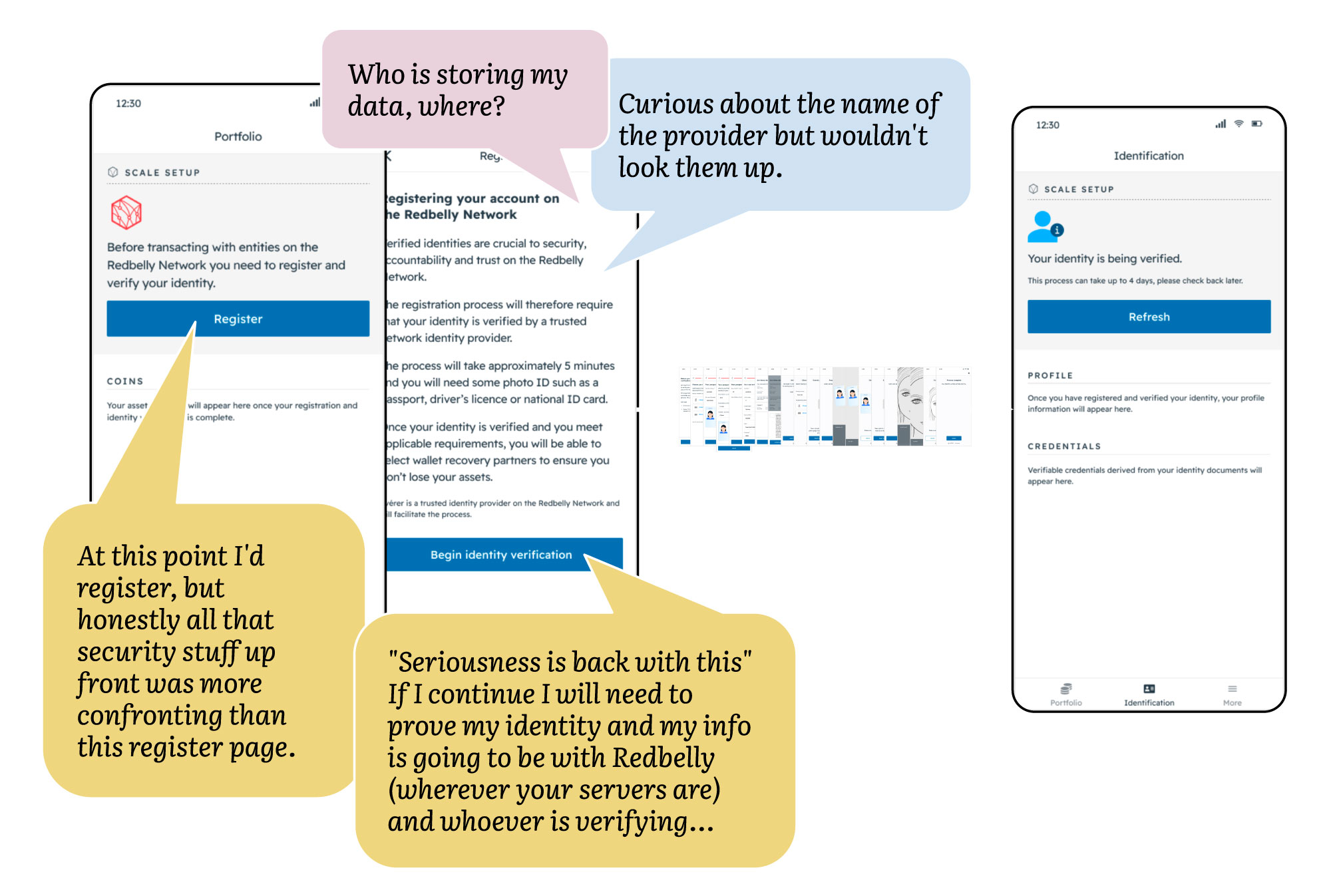 Participant feedback about the registration process.
Participant feedback about the registration process.
Recovery setup
- Participants were indifferent to the profile and credentials, unsure of what they were for once their identity had been verified.
- While participants were able to decipher the basic way the recovery concept worked, they had questions about how exactly the partners were involved, where they stored the data and how.
- Participants more experienced with crypto wallets expected a more self-custodial approach to recovery, such as safe-keeping a passphrase.
- Participants would select entities they had pre-existing relationships with and already “trusted” with their sensitive data.
- Participants more familiar with crypto wallets were confused by the notion of “recovery code” in this context.
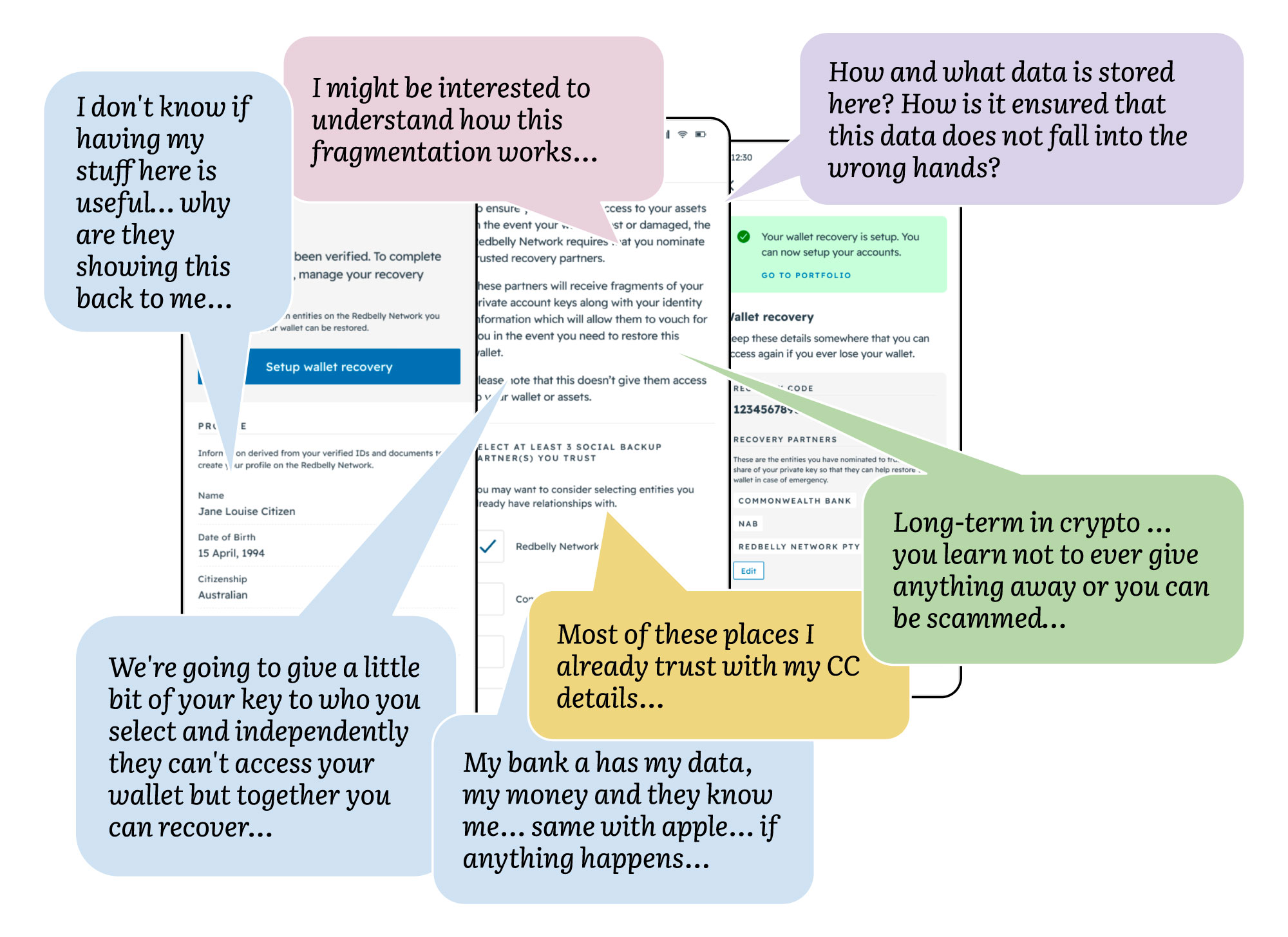 Participant feedback about the recovery setup.
Participant feedback about the recovery setup.
Creating accounts and sharing details
- All participants managed to create an account and find the details which they needed to share for the transaction.
- Some participants would share the details through the native share mechanism offered, others would prefer to “copy” the public address to their clipboard and share it manually.
- Participants explored the QR feature first, expecting that it could be used for transactions.
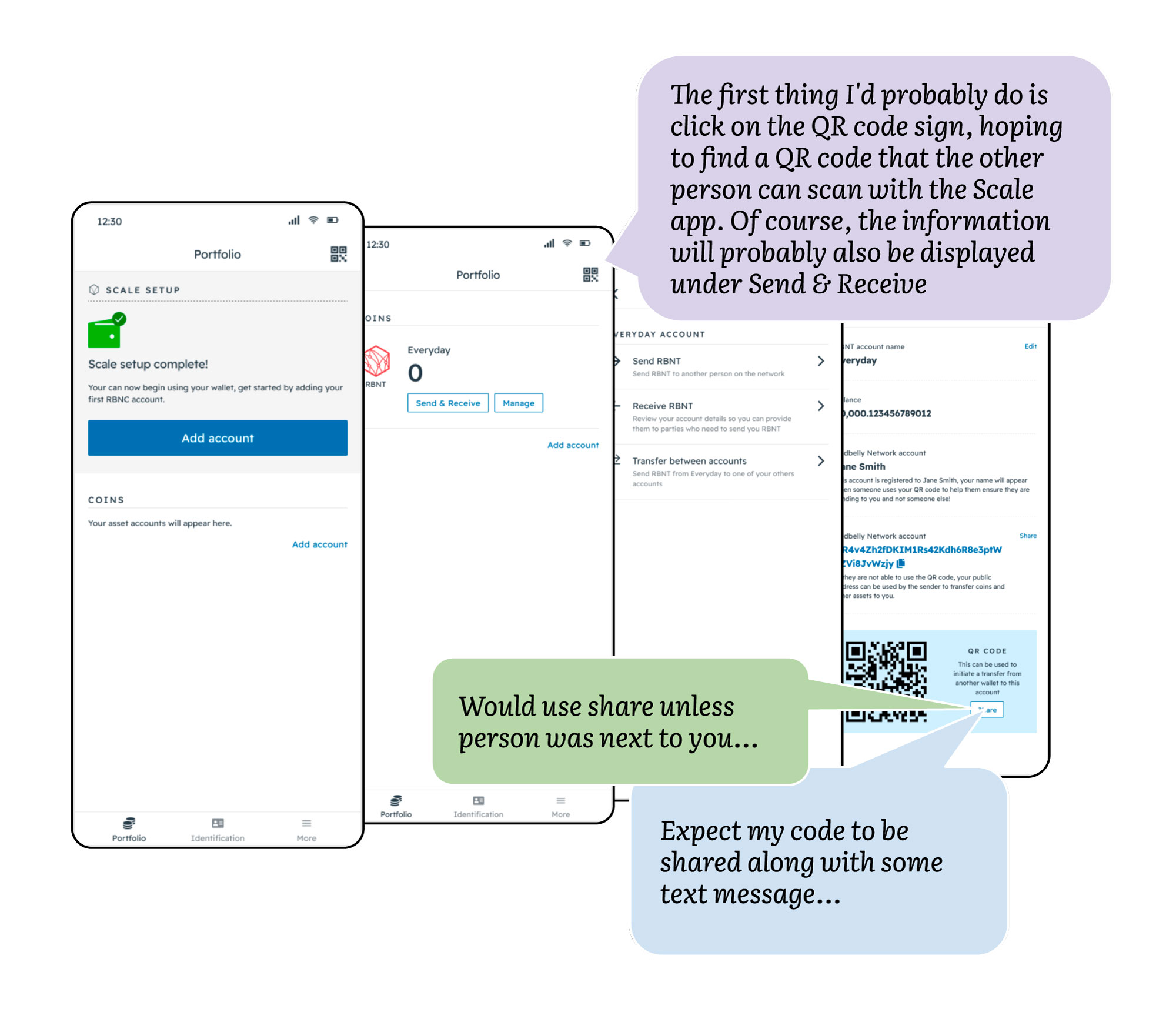 Participant feedback about fetching and sharing account details.
Participant feedback about fetching and sharing account details.
Testing takeaways
Syntheses
- All participants were able to complete tasks, understanding what was expected of them at each step.
- There was some confusion regarding how the app is secured locally.
- Guardian-based wallet recovery could be a barrier for some crypto purists who prefer to store their private keys on a piece of paper.
- Self-custody was not evoked through the experience, therefore, registration was seen as a signing up to centralised service, Redbelly or Scale. All subsequent processes therefore required trust in that entity for things it wasn’t actually going to do such as store or have access to the user’s data.
- Participants more experienced with crypto and self-custodial wallets, translated all the terms and signals through the lens of other wallets.
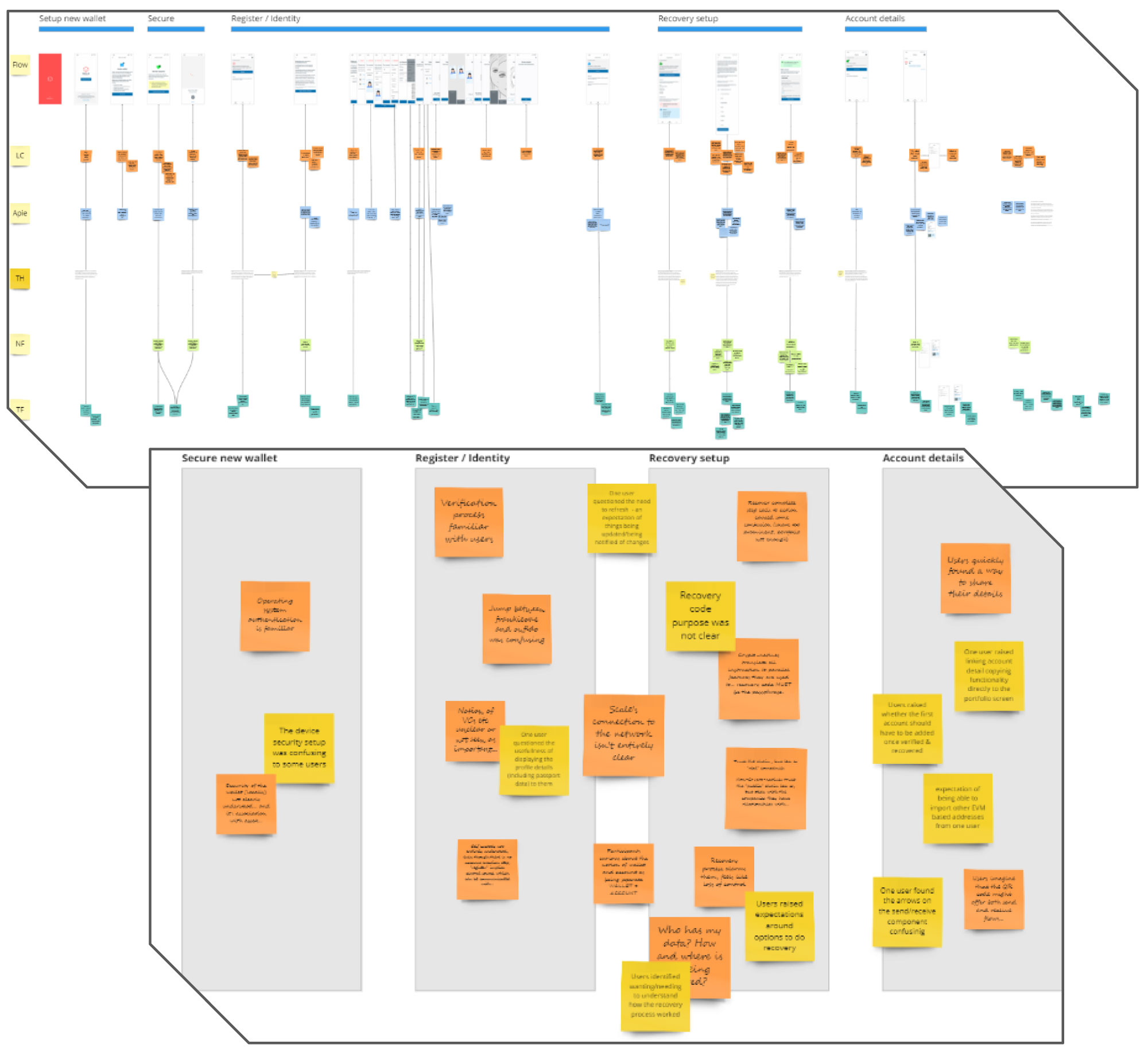 Miro was leveraged for product team syntheses exercises.
Miro was leveraged for product team syntheses exercises.
Actions
To improve the exprience, the following recommendations we applied.
- Tone down security signals. While the mechanism was understood, the language caused more anxiety than intended.
- Reframe what “register” means and improve the context around verifiable credentials.
- Break down the recovery concept in terms of what it ensures, the benefit of being identity-based and why it’s more secure than traditional methods while also offering more detail about how it technically works.
- Leave as is and review when there is a larger user base storing assets and making transactions.




 Tables from exercises which helped select the appropriate format for the Scale wallet.
Tables from exercises which helped select the appropriate format for the Scale wallet.
 Early wireframe/storyboard hybrid for the Scale design.
Early wireframe/storyboard hybrid for the Scale design.
 Scale on-boarding screens.
Scale on-boarding screens.
 The Scale identification tab provides users visibility of their Redbelly profile and Verifiable Credentials.
The Scale identification tab provides users visibility of their Redbelly profile and Verifiable Credentials.
 Scale recovery setup flow.
Scale recovery setup flow.
 Scale account management screens.
Scale account management screens.
 Scale transfer flows.
Scale transfer flows.
 Scale participation conditions.
Scale participation conditions.
 Table showing the success of each task, versus their interpretation of underlying concepts.
Table showing the success of each task, versus their interpretation of underlying concepts.
 Participant feedback about the onboarding experience.
Participant feedback about the onboarding experience.
 Participant feedback about the registration process.
Participant feedback about the registration process.
 Participant feedback about the recovery setup.
Participant feedback about the recovery setup.
 Participant feedback about fetching and sharing account details.
Participant feedback about fetching and sharing account details.
 Miro was leveraged for product team syntheses exercises.
Miro was leveraged for product team syntheses exercises.